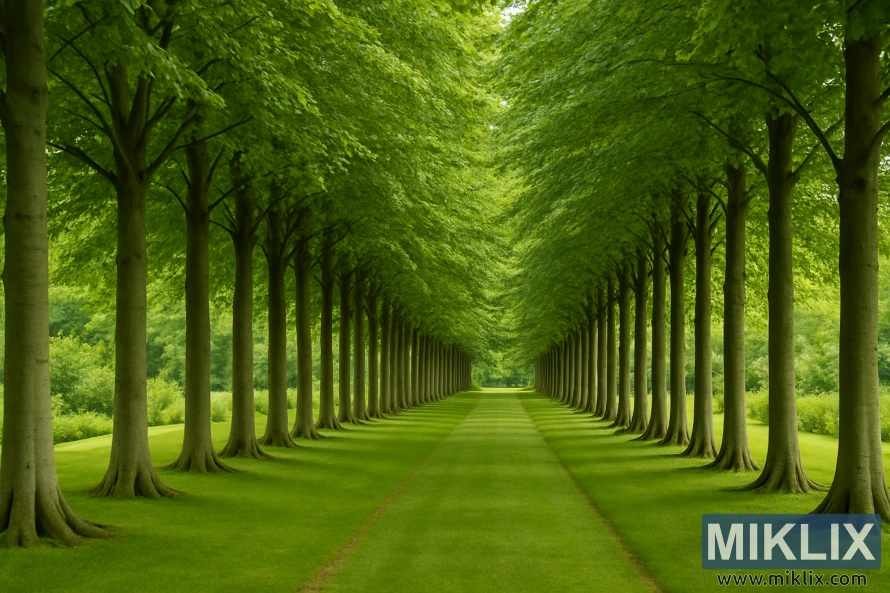Image: Beech Tree Allée
Published: August 28, 2025 at 10:13:39 AM UTC
Last updated: September 28, 2025 at 8:38:13 AM UTC
A dramatic allée of European Beech trees with smooth gray trunks and arching green canopies creates a symmetrical walkway with dappled shade.
This image captures the breathtaking grandeur of a beech allée, a living corridor where nature and design harmonize in perfect symmetry. On either side of the long, straight path, evenly spaced European Beech trees (Fagus sylvatica) stand like sentinels, their smooth, silver-gray trunks rising with dignified grace. Each tree flares subtly at its base, anchoring itself firmly into the lush green lawn, before narrowing into a tall, columnar form that draws the eye upward. Their trunks, aligned with mathematical precision, create a rhythm of vertical lines that echo across the landscape, a reminder of how careful planning can harness the raw beauty of nature to achieve an atmosphere of timeless order and elegance.
Above, the trees’ expansive crowns reach out toward one another, their dense canopies of vibrant green leaves intertwining to form a continuous overhead arch. This vaulted canopy transforms the allée into a kind of natural cathedral, where sunlight is softened and filtered through the leaves, scattering into a mosaic of dappled patterns on the grass path below. The air feels cooler, quieter, and imbued with a sense of tranquility beneath this leafy ceiling, as if the canopy itself muffles the outside world and creates a serene sanctuary for reflection, walking, or simply pausing to admire the view.
The perspective of the composition emphasizes depth and continuity. The perfectly aligned rows of beeches guide the gaze forward, converging at a distant vanishing point that seems to stretch into infinity. This narrowing perspective not only heightens the sense of drama but also showcases the architectural power of trees when used in repetition. The straight path, bordered by evenly mown grass, reinforces this visual journey, turning a simple walkway into a profound aesthetic experience that embodies rhythm, discipline, and grandeur.
Yet the beauty of this allée is not only in its symmetry, but also in the way it frames the landscape. Each tree contributes to the collective whole, creating a corridor that defines space without enclosing it, offering both structure and openness. The filtered light, the soft rustling of leaves in the breeze, and the interplay of shadow and sun lend the allée a dynamic character that changes with the time of day and the shifting seasons. In spring and summer, the canopy glows in vibrant greens, while autumn would transform the corridor into a tunnel of gold and copper, and in winter, the bare branches would create a stark, skeletal tracery against the sky, proving that the design holds beauty in every season.
This image demonstrates why beech trees are celebrated as one of the best species for creating such dramatic features. Their smooth trunks, dense foliage, and capacity for uniform growth make them ideal for allées, where consistency is key to achieving the desired formal effect. The result is not only visually striking but also deeply symbolic: a testament to humanity’s ability to work alongside nature, creating landscapes that honor both natural beauty and artistic vision.
Ultimately, the beech allée exemplifies the timeless appeal of formal garden design. It is more than a pathway—it is a living architecture of leaves and branches, a corridor that conveys both majesty and intimacy. Walking through it, one is enveloped by the structure of the trees and the softness of their foliage, experiencing firsthand the elegance, order, and tranquility that such a design can inspire. It is a reminder of how landscapes, when thoughtfully shaped, can stir emotions, guide the spirit, and stand as enduring works of art crafted not from stone or steel, but from the living, breathing fabric of nature itself.
The image is related to: Best Beech Trees for Gardens: Finding Your Perfect Specimen

